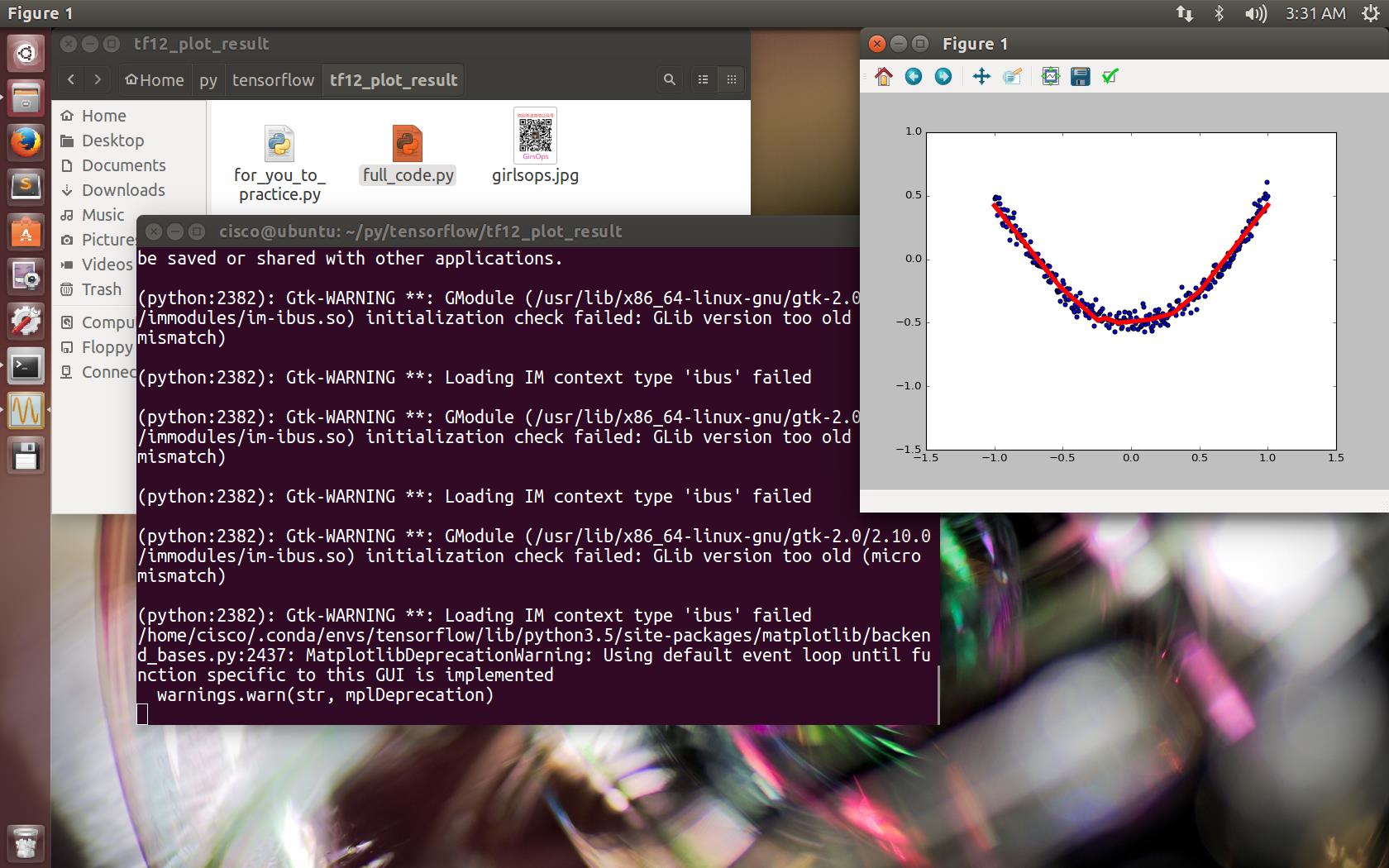Tensorflow的对二次函数的神经网络训练
Posted Mnster_Lu
tags:
篇首语:本文由小常识网(cha138.com)小编为大家整理,主要介绍了Tensorflow的对二次函数的神经网络训练相关的知识,希望对你有一定的参考价值。
这个是tensorflow的一个YouTube上的教程。
作为学习资料,拿来敲了一遍。
这是对一个二次函数的进行神经网络的训练
import tensorflow as tf import numpy as np import matplotlib.pyplot as plt def add_layer(inputs, in_size, out_size, activation_function=None): Weights = tf.Variable(tf.random_normal([in_size, out_size])) biases = tf.Variable(tf.zeros([1, out_size]) + 0.1) Wx_plus_b = tf.matmul(inputs, Weights) + biases if activation_function is None: outputs = Wx_plus_b else: outputs = activation_function(Wx_plus_b) return outputs # Make up some real data x_data = np.linspace(-1, 1, 300)[:, np.newaxis] noise = np.random.normal(0, 0.05, x_data.shape) y_data = np.square(x_data) - 0.5 + noise ##plt.scatter(x_data, y_data) ##plt.show() # define placeholder for inputs to network xs = tf.placeholder(tf.float32, [None, 1]) ys = tf.placeholder(tf.float32, [None, 1]) # add hidden layer l1 = add_layer(xs, 1, 10, activation_function=tf.nn.relu) # add output layer prediction = add_layer(l1, 10, 1, activation_function=None) # the error between prediciton and real data loss = tf.reduce_mean(tf.reduce_sum(tf.square(ys-prediction), reduction_indices=[1])) train_step = tf.train.GradientDescentOptimizer(0.1).minimize(loss) # important step init = tf.initialize_all_variables() sess= tf.Session() sess.run(init) # plot the real data fig = plt.figure() ax = fig.add_subplot(1,1,1) ax.scatter(x_data, y_data) plt.ion() plt.show() for i in range(1000): # training sess.run(train_step, feed_dict={xs: x_data, ys: y_data}) if i % 50 == 0: # to visualize the result and improvement try: ax.lines.remove(lines[0]) except Exception: pass prediction_value = sess.run(prediction, feed_dict={xs: x_data}) # plot the prediction lines = ax.plot(x_data, prediction_value, \'r-\', lw=5) plt.pause(1)

import tensorflow as tf import numpy as np import matplotlib.pyplot as plt def add_layer(inputs, in_size, out_size, activation_function=None): Weights = tf.Variable(tf.random_normal([in_size, out_size])) biases = tf.Variable(tf.zeros([1, out_size]) + 0.1) Wx_plus_b = tf.matmul(inputs, Weights) + biases if activation_function is None: outputs = Wx_plus_b else: outputs = activation_function(Wx_plus_b) return outputs # Make up some real data x_data = np.linspace(-1, 1, 300)[:, np.newaxis] noise = np.random.normal(0, 0.05, x_data.shape) y_data = np.square(x_data) - 0.5 + noise ##plt.scatter(x_data, y_data) ##plt.show() # define placeholder for inputs to network xs = tf.placeholder(tf.float32, [None, 1]) ys = tf.placeholder(tf.float32, [None, 1]) # add hidden layer l1 = add_layer(xs, 1, 10, activation_function=tf.nn.relu) # add output layer prediction = add_layer(l1, 10, 1, activation_function=None) # the error between prediciton and real data loss = tf.reduce_mean(tf.reduce_sum(tf.square(ys-prediction), reduction_indices=[1])) train_step = tf.train.GradientDescentOptimizer(0.1).minimize(loss) # important step init = tf.initialize_all_variables() sess= tf.Session() sess.run(init) for i in range(1000): # training sess.run(train_step, feed_dict={xs: x_data, ys: y_data}) if i % 50 == 0: # to see the step improvement print(sess.run(loss, feed_dict={xs: x_data, ys: y_data}))

以上是关于Tensorflow的对二次函数的神经网络训练的主要内容,如果未能解决你的问题,请参考以下文章